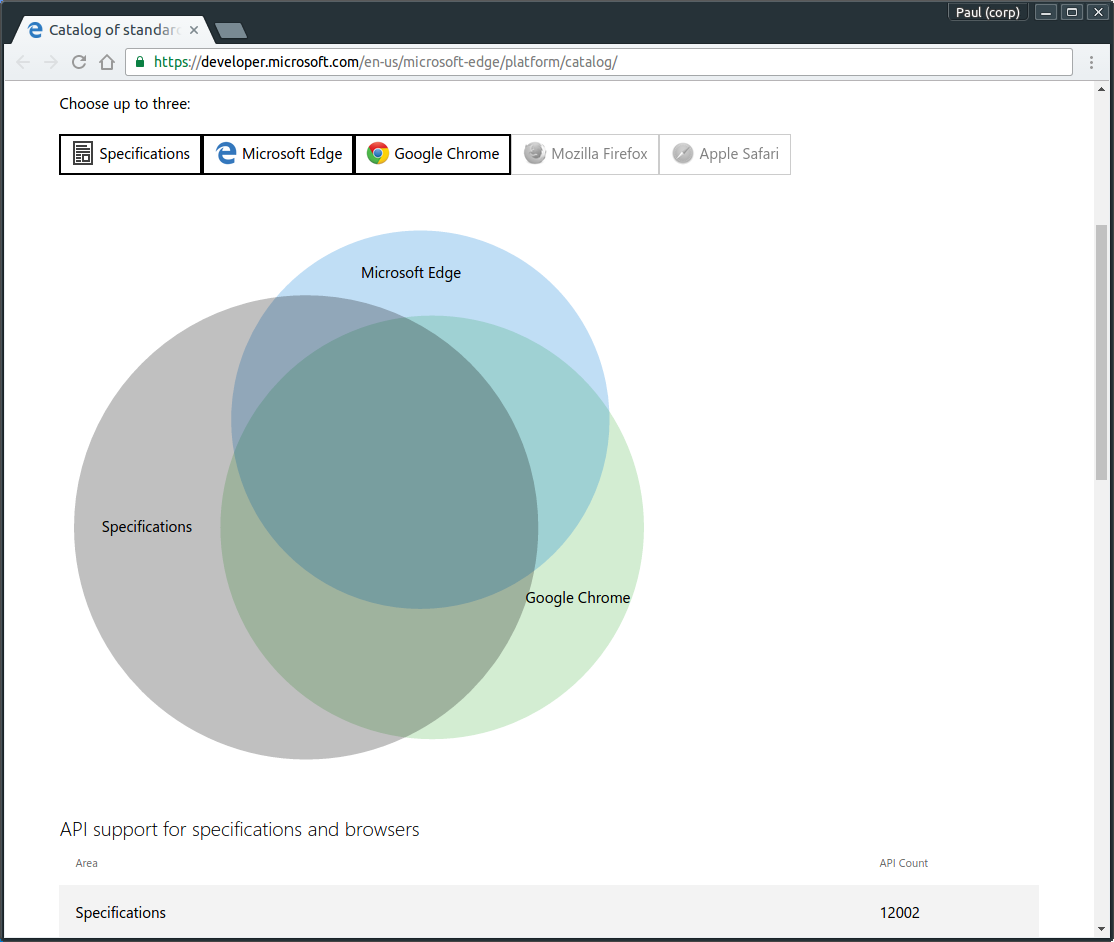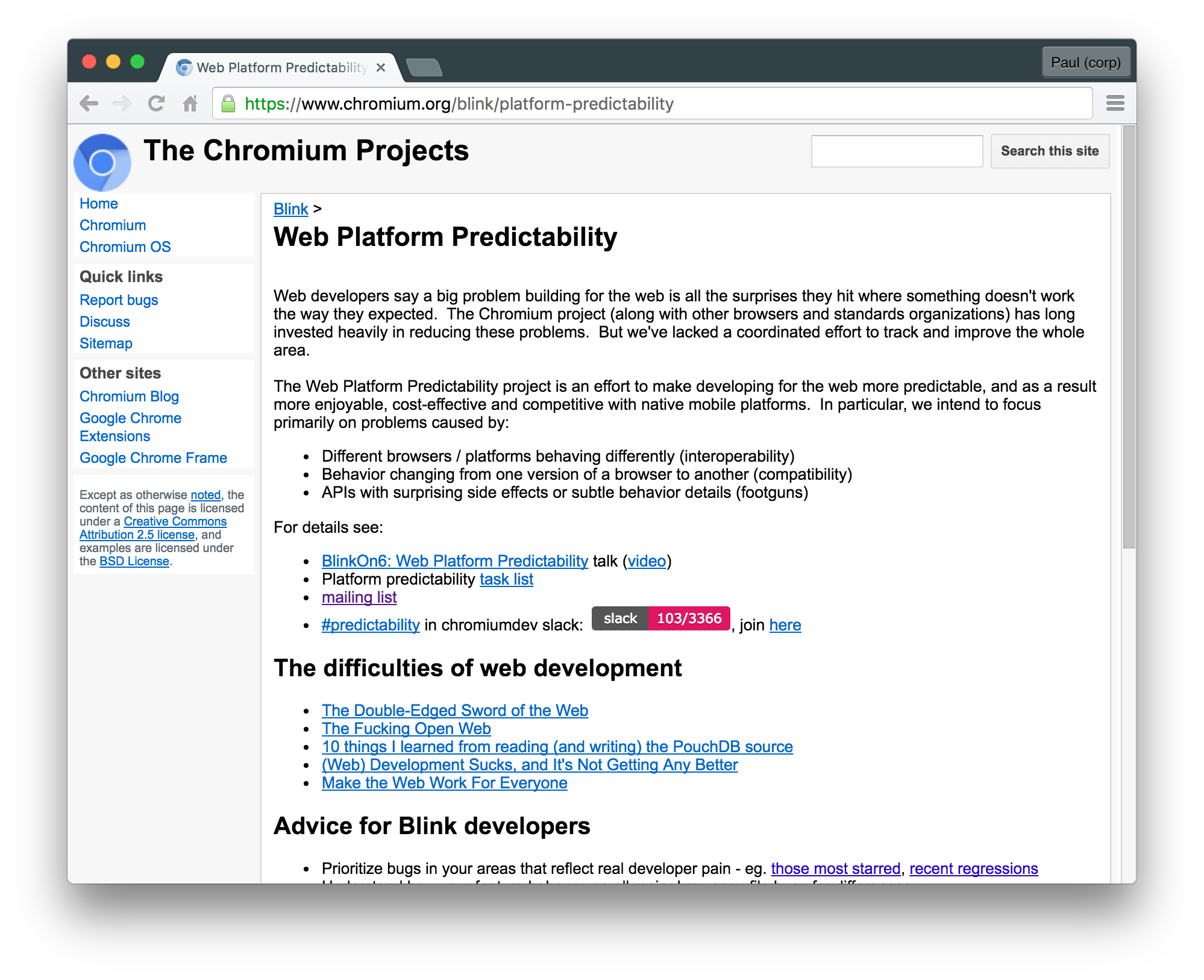It's well over a year since I started to write this post, but there have been a couple of things that have happened recently that I finally dusted of the digital cob webs and started to write it up again. I started to think about writing it when I was presenting This is the web platform at Fronteers in Amsterdam in 2014.
I was doing a lot of research off the back of caniuse.com and I was building out iwanttouse.com and a little CLI to query the data so that I could start to see broadly how compatible the web is.
The Lumpy Web
In no uncertain terms the web is lumpy. There are many different types of Internet connected devices each with different capabilities in terms of context of use (mobile, desktop, kiosk, [insert any future platform here]), each of these devices normally has a browser on it so that the user can use the Web.
Taking the context of use out of the question, there are still a bewildering set of options for us to consider.
There are many different types of "Engines": Blink, WebKit, Gecko, EdgeHTML... each Engine can power many different Browsers created by Browser vendors such as: Apple, Google, Microsoft, Opera, Samsung, Baidu, Dolphin, ... WeChat, Facebook, the list goes on, all develop their systems at different cadences of launch and with each adding new features, fixing inconsistencies, introducing bugs and removing legacy features and having to potentially maintain many version of the browser that the users have in the wild.
The web is incredibly diverse. This is a good thing, but it presents challenges for developers. Challenges that I don't think we fully understand and that I want to try and raise awareness of.
Lumps, Bumps and Humps
I've tried to classify the types of problems in to a number of "classifications" (honestly, I am not shoehorning these classifications into these categories because I thought of a snappy name for the title of this blog post).
Lumps: Browsers are hard to build, Specs are hard to write and all of it is created by people. It's easy for implementation differences to occur. As a developer when you expect something to work and it doesn't then it causes you a huge problem. You have to deal with all of the different browsers, you have to manage the fact that different versions of the same browser may implement different versions of the API's that you rely on.
Bumps: The specifications defining the web evolve and change and as consensus builds at standards bodies, then browser vendors will start to implement the features. This can result in a mismatch of features and implementations.
There is a point where as a developer you can take a risk and decided to build your software and sites.
We recently saw this with ES2015. Everyone was committed to shipping, but Chrome, Safari, Edge and Mozilla all have different release schedules and as such you know something is going to be ubiquitous, but not exactly when it will be. There were tools that let you build using ES2015 and ship using ES5. There was a great talk at IO by Matt Gaunt and Sam Saccone called "The 2016 Web Development Workflow" in which Matt and Sam argue that you can now flip that around, you can build and iterate locally using all the latest tooling and then at deploy time ship with a compatibility layer. The Bumps are clear, but we can work around them effectively because we clearly can see what they are.
Humps: Browser vendors have their own priorities about what features are implemented and when. In many cases consensus is reached across browser vendors and they will ship an API. In some cases there is an internal customer and priority that a company might have that needs an Open Web Platform feature and thus that gets shipped before other browsers. Sometimes the browser vendors have a vision for the web and they start to build out that part of the web platform before anyone else, and sometimes staffing and their skills affect, heck if you don't have engineers that understand video and streaming it is unlikely that you will prioritize shipping an API like Web RTC.
In some cases this means that no other vendor will ship a feature for a relatively long time creating a pronounced hump in the web. As a web developer you have two choices: Do or don't. It is however pretty clear.

We have Lumps, Bumps and Humps. How do we deal with them?
Telescopes, Binoculars and Microscopes;
If you have ever been in a field you will know this, but imagine you are walking across a the countryside: You can see the humps from a mile away and you can make a choice and decide to tackle it or tak around it. Bumps too, they are harder to see from a far but you can. It's the Lumps that trip you and can do real damage. Because you can't easily see the obstacle, it's the one that causes the most damage. Because you can't predict the capabilities of the platform, you can't have the confidence that you need to build for it and you slow down as you try to navigate the field.
Predictability is a great thing in hindsight.
Luckily developers have been thinking about this for a long time and many tools have been created to help us web developers. I like to think of them in terms of the granularity that they give us.
Telescopes:
A number of tools exist that give us an overview of what the web platform is capable of. They remind me of a telescope, they let you get a sense of a full picture of the platform however the resolution is limited. It's like looking at Jupiter with the Hubble Space Telescope: you can get so much information from it that we wouldn't get normally, but it's a little blurry, the details you need are not clearly visible.
Caniuse.com and HTML5Test are two great examples of projects that we all use everyday.
Binoculars:
Most of the Browser vendors have a status page where you can see what features have been shipped, which features are being worked on, and which are planned (or not) for future work. These tools give you an insight in to what is being worked on but they are normally from
These are great tools created by the Browser vendors to give you an idea of what they have been working on and what they are working now and what they are considering to work on in the future. This data gives us developers a great reference point.
We even get to understand the usage of certain features.
- Microsoft's measured feature popularity
- Chrome's measured CSS popularity
- Chrome's measured JS popularity
Great tools, but again the resolution is not as good as you need.
Microscopes:
We don't quite have the tools needed (browser vendors and web developers) to understand the platform as a whole. We don't really know how compatible Browsers are with the web.
But there are efforts underway at the moment to help understand this.
These tests are normally run by the browser vendors to test how compatible their implementations are with the spec. The Web Platform Tests (started by test the http://testthewebforward.org/)
I would also argue that Kangax compatibility tables for es6 fit in here too, a deep understanding of the state of the web in the filter of es6
What do we need?
If you go back to field analogy you have many ways to make it smoother, you can use a garden roller to iron out some of the lumps in your garden, but to clear the humps we need something a lot bigger. We need a Steamroller.
What we don't have is an easy way to run and aggregate the data and truly understand actually what the platform is doing and in a way that developers can consume. I am hopeful that caniuse.com, HTML5Test or anyone start to integrate these test suites into their products so we can start to get that intelligence about the capabilities of the web platform.
These are all great tools that can give you a huge amount of insight into the web platform and can give you the confidence that you need to deploy on the platform, but they don't fix the fundamental issue: The platform needs to be less bumpy and a lot more predictable.
Microsoft have done a great job at working out how interoperable the web is, you should check out the Platform Visualizer.

It was incredibly interesting to learn about how they gathered this data for this tool.
Browser information was gathered by traversing the type system within the latest available version of the top browsers. Specification data was gathered by extracting Web IDL definitions from notable web specifications.
It's incredibly hard to get this data, but it's incredibly valuable.
Rick Byers on the Chrome team also recently started the Web Platform Predictability project in Blink

The reason that I finally got around to writing this post now is that people are starting to work on this area a lot more and there are a number of things coming together that gives me hope.
Lumps, Humps and Bumps. We need to make the Web smoother, more predictable.
</tired-analogies>
My vision for a happier developer life
- Platform inconsistencies hurt us more than big feature differences, we should start to try and prioritize aligning the platform
- We need better tools to help us understand what the inconsistencies are and guidance on how to manage them
- Developers should raise more issues to keep browser vendors accountable when there are differences
I would love to see a dashboard of all the runs across all of the browsers against Web Platform tests.
I would love to see tools like HTML5Test and CanIUse.com be backed off the data generated by these tests.
I would love to see tools like HTML5Test and CanIuse.com get the granularity of Microsoft's visualizer.
I would love the data traffic data from caniuse.com and html5test to be applied against the data that Microsoft extracted so vendors could infer the pain points that developers hit and work on prioritizing those fixes.
I would love to see a more consistent web at the lower levels.
I am hopeful.
Edit: 17th Nov 2016: Adding in Mozilla.
Header image credit: Phoenix Wolf-Ray
I lead the Chrome Developer Relations team at Google.
We want people to have the best experience possible on the web without having to install a native app or produce content in a walled garden.
Our team tries to make it easier for developers to build on the web by supporting every Chrome release, creating great content to support developers on web.dev, contributing to MDN, helping to improve browser compatibility, and some of the best developer tools like Lighthouse, Workbox, Squoosh to name just a few.
I love to learn about what you are building, and how I can help with Chrome or Web development in general, so if you want to chat with me directly, please feel free to book a consultation.
I'm trialing a newsletter, you can subscribe below (thank you!)




